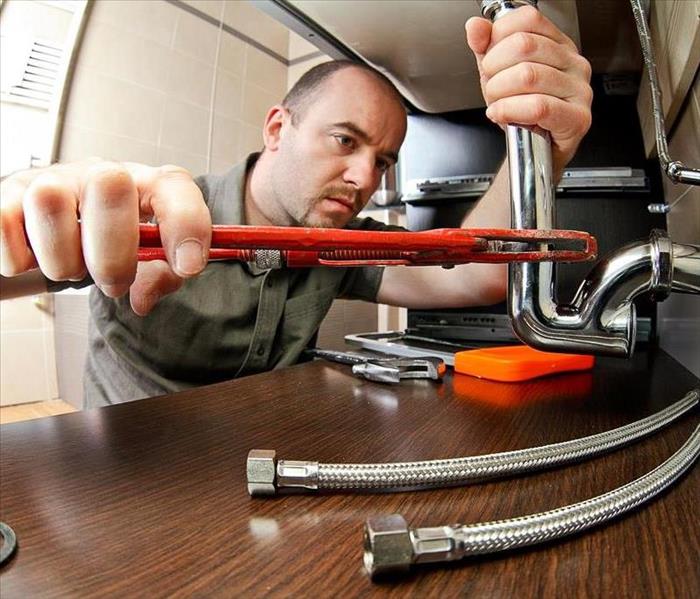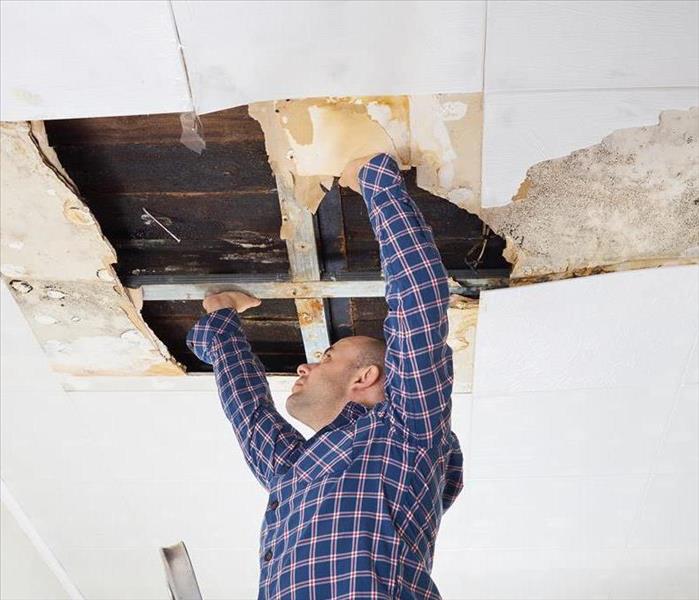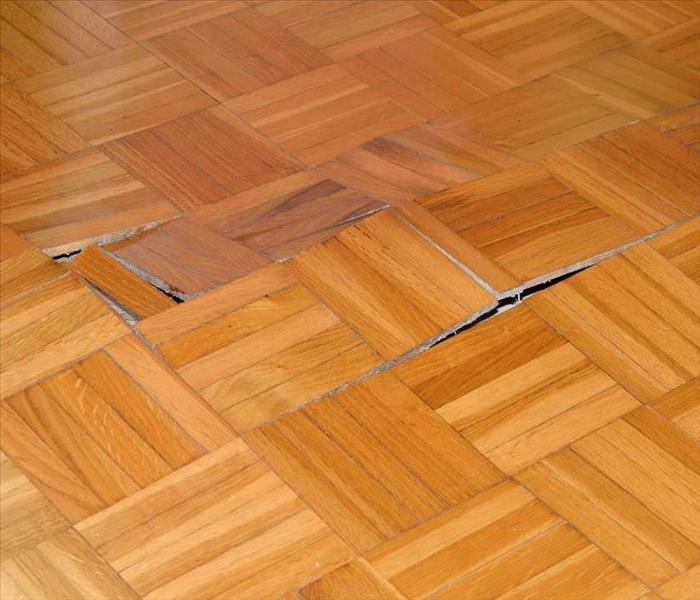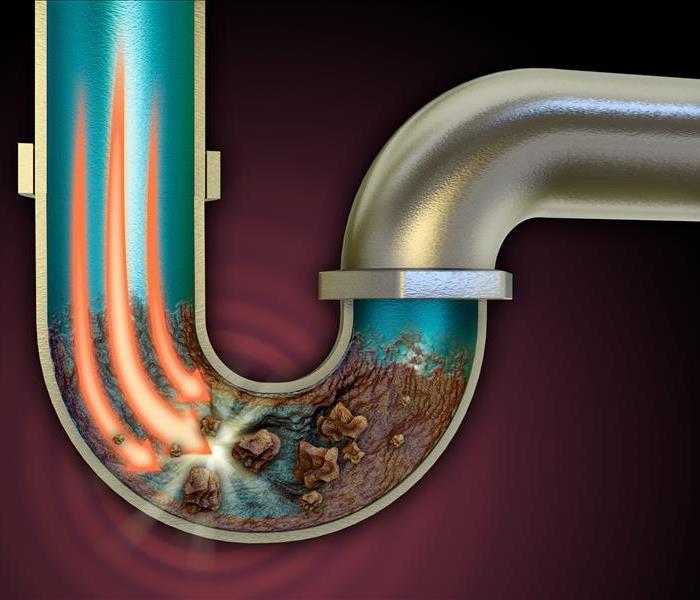Archived Why SERVPRO Blog Posts
How Frozen Pipes Put Your Home at Risk
6/13/2022 (Permalink)
 Learn more about Frozen Pipes by following these Tips.
Learn more about Frozen Pipes by following these Tips.
Throughout much of the country and in all parts of Canada, temperatures have the potential to fall below zero. In certain conditions, that could result in pipes that rupture and spray large quantities of water into your home in Sandy, UT.
When this happens, your home is at risk for multiple forms of water damage. Electronics could be destroyed, flooring could suffer warping, insulation could be rendered useless and furniture could need to be replaced. If you are faced with this problem, calling a local SERVPRO franchise will likely be your best option.
Solid Methods To Avoid Frozen Pipes
The best solution is to avoid letting your pipes freeze in the first place. When this happens, the expansion of the water in the pipes to ice can result in broken plumbing components. A few precautions can nearly eliminate this from happening:
- Make sure the temperature in the home never falls too low
- Wrap pipes that have an outdoor exposure in an insulated covering
- Have someone monitor your home if you are away for a week or more
- Pay attention to unusual cold snaps in your region
At times, through no fault of your own, you could experience a pipe freeze. This could happen due to a power outage, similar to what happened in Texas in 2021. At this stage, you might need to turn your attention to a professional water cleanup.
The Best Process for Dealing With a Pipe Burst
Once you discover significant water has leaked somewhere in your home, you will need to call for professional help. A nearby SERVPRO franchise works 24/7 and is always available with trained technicians to help out. The #1 choice in cleanup and restoration is Faster to Any Size Disaster and they will likely dispatch a crew to your home within two hours. Professionals understand that a fast response to frozen pipes can reduce damage and expenses.
After an initial inspection and damage assessment, the team will work quickly to improve the situation. The following steps are critically important:
- Stopping the flow of water
- Ensuring safety for everyone
- Establishing an effective plan of action
- Limiting damage through timely water removal
Workers will see what materials in the home can be restored and what will need to be replaced. They will have an orderly process for identifying salvageable items and then they will use the most effective restoration techniques.
The Important Methods for Completing the Cleanup
After the initial stage, the team will go to work on sanitizing, cleaning and deodorizing your home. This process makes use of specially formulated cleaning agents and addresses impacts to flooring, furniture and personal belongings. It makes sure no odors linger and reduces the chance of mold forming on surfaces. Drying technicians also make sure the home returns to a comfortable humidity level.
Frozen pipes can damage your home in many ways. If a pipe breaks, a fast response is required by a professional organization to reduce damages and manage a successful cleanup and restoration. A SERVPRO franchise will use the best methods to restore your home to its original condition.
The Benefits of 24-Hour Response
4/25/2022 (Permalink)
 24-Hour Response is the Best Option for your Sandy, UT Property.
24-Hour Response is the Best Option for your Sandy, UT Property.
Disasters don't just happen during regular business hours. Because fire or water damage can happen at any time, it makes good sense to work with a preferred vendor with 24-hour availability.
SERVPRO can take a call, send a response team and provide a detailed report of the damage and what needs to be done about it within hours, regardless of when the company receives notice of the problem.
24-Hour Response
When an accident damages a building, every moment counts. Many problems can occur when mitigation is delayed:
- Weakened structure
- Hidden water damage
- Mold growth
- Additional spread of the problem
The SERVPRO call center is open 24 hours a day. This guarantees a fast response on any call that comes in. For example, if your client receives notice from the overnight security guard that a frozen pipe has busted in his or her building, there's no need to wait until morning to get the cleanup process started. The local team is notified that its services are needed immediately.
On-Site Arrival
Timely arrival is the key to fixing an issue before it gets too out of hand. Once the certified mitigation specialists in Sandy, UT, know there's a problem, they can assemble a team and be at the building within four hours. They go to work immediately, surveying the area and preparing the task list for the whole restoration process.
Upon arrival, technicians gather information about the safety precautions that have been taken up to that point. Has the water main been shut off? Has the circuit breaker been flipped to avoid electric shock? If anything else needs to be done, they make sure it happens before the work begins.
Another benefit of 24-hour service is that your client doesn't have to worry about his or her building being left vulnerable to the elements or other intrusions. During the first visit, the team can board up holes in the roof, siding, windows and doorways to deny entry to thieves, vandals and animals.
Efficient Assessment
A thorough assessment is necessary for many reasons. It helps the mitigation team prepare what it needs for the cleanup process. It also lets your clients file accurate claims, which makes the process easier for them and for the insurance adjusters who are assigned to their cases. You know from the beginning of the cleanup process what the entire restoration process will look like and approximately how long the mitigation team expects it to take to complete.
Because SERVPRO is always open, the technicians who respond to the call can have a detailed estimate ready to go over with your client within eight hours of arriving on site. Before work begins, the team lead conducts a verbal briefing with the building owner. Your client has the opportunity to ask questions so that he or she understands what to expect from the mitigation process.
For 24-hour response and superior damage control, you can rely on SERVPRO to meet your clients' needs. The local team is Faster to Any Size Disaster, starting cleanup within eight hours of being notified there's a problem.
Water Damage and Building Materials
3/29/2022 (Permalink)
 Know more about Water Damage and Building Materials By Following Our Tips.
Know more about Water Damage and Building Materials By Following Our Tips.
Depending on the extent of water damage to your home, you might wonder about what materials are salvageable. The general rule, especially when dealing with category three damage, is to discard as much as possible, primarily any porous materials that came into contact with the contaminated water supply. However, even in situations of clean water damage, materials, like swelling wood, might not be salvageable.
According to most water restoration services in Sandy, UT, water affects building materials differently, the following are three potential examples.
1. Insulation and Swollen Wood
Swelling wood is likely beyond saving, especially if it is a laminate material. The swelling means the water has sat long enough on the surface to soak beneath any seal coat. When wood swells it expands and distorts, making it hard to salvage, especially when not solid wood.
Insulation is typically discarded after a water pipe repair because it is a favorite nesting site for mold. Mold establishes itself within 24 to 48 hours of a leak. Standard insulation is porous and cheap enough to replace without concern. If insulation is foam-based, mitigation specialists might try to save it — if they can dry the surrounding areas.
2. Drywall and Solid Wood
If the exposure time is limited and drywall and solid wood elements have not been contaminated, it is possible to salvage furniture and wallboard. However, salvaging these materials depends on the contamination level or the water.
3. Flooring and Ceiling Tiles
If a supply line in the ceiling or beneath the flooring of your home, it is quite possible the materials will be removed. Ceiling tiles are typically porous and will expand when wet, similar to flooring. The subfloor can twist and swell also causing problems with the home's structure.
Water can lead to swelling wood, but it can also lead to mold growth and numerous other problems. It is crucial to know what materials are salvageable after water damage. While the above list is helpful, it is not exhaustive.
How to Snake a Clogged Drain the Easy Way
2/19/2022 (Permalink)
 Contact a professional to avoid further damage from a clogged drain.
Contact a professional to avoid further damage from a clogged drain.
A clogged pipe can be a real hassle, especially when it affects the drain in a bathroom or kitchen sink. However, aside from the annoyance of slow draining water, a clog can lead to much larger issues, like a pipe break. There is no reason you have to struggle with a minor clog. Using an auger or drain snake, you can loosen and break apart the clog, allowing the water to flow freely, and protecting your pipes against future wear.
Despite the ease of using an auger, some clogs will be too far into the pipe, requiring a professional plumber in Sandy, UT. Professionals are typically required in instances of:
- Pipe collapse
- Root growth
- Sewer line problems
What Is a Blocked Drain?
A clogged drain is defined as an obstruction that slows down the flow of water and reduces the water pressure that goes into the drain pipes. While clogs are often caused by natural factors (e.g., food, leaves, and debris blocking the pipes), they can also be caused by neglect, poor maintenance, or failure to follow the general best practices in house maintenance.
In most cases, the clog is located near the affected drain. When the blockage is close to the drain, a simple tool, such as an auger, is the best way to eliminate the blockage and free up a stopped drain.
Do not use drain cleaners or other harsh chemicals to free a blockage. Using chemicals can damage the pipes. Additionally, using multiple chemicals can cause adverse reactions, like eruptions in the pipe.
How To Snake a Blocked Drain
Manual augers or snakes are affordable tools for clearing away blockages. The tool consists of a coiled wire with a twisted head.
You will insert the head of the snake into the drain, slowly pushing it deeper and deeper. When you reach the first bend, twist the handle in a circular motion to rotate the wire. Move the auger back and forth until it navigates the bend. Then continue pushing the auger into the pipe. When you reach the clog, turn the handle again, pushing back and forth until you feel the wire clear the clog.
When Do You Need To Call a Plumber?
Most manual augers only reach a depth of 25 feet. If you do not feel a clog after fully extending the auger, you might need to contact a plumber because the blockage is likely further in the system.
Additionally, you will want to contact a plumber if you have broken up the clog and your drain is still blocked. If your pipe is still blocked, it likely indicates a problem further in the line.
Professional plumbers have the tools necessary to assess and reach deep clogs. While you can purchase these tools, the expense does not often justify the DIY approach.
A clogged pipe is a nuisance. Using a manual auger or snake is usually enough to resolve most home drainage issues. However, there are instances when blockages deeper in the system or other problems are causing the current issues. Contact a professional for assistance when you are dealing with an unknown issue and have tried the simple solution.




 24/7 Emergency Service
24/7 Emergency Service



